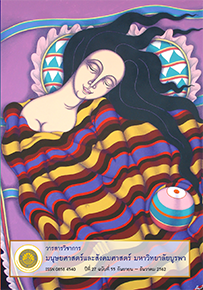Thai Restaurants in Ho Chi Minh City: Capital of Thainess, Existence and Trend
Main Article Content
Abstract
This qualitative research entitled “Thai Restaurants in Ho Chi Minh City: Capital of Thainess, Existence, and Trend” was conducted with 3 purposes: 1) to study the origin and development of Thai restaurants in Ho Chi Minh City, and Vietnamese government policy related to foreigner investor, 2) to examine the capital of Thainess in Thai restaurants andthe viewpoint about consumption of Thai food of the Vietnamese, and 3) to study the existence and the tendency of Thai restaurants in Ho Chi Minh City.
The findings revealed that after Vietnam opened its country and implemented “Đổi Mới” economic reform in 1986 to promote foreign investment, Thailand was one of foreign countries investing in various kinds of business in Vietnam. Thai restaurant was one of businessesthat Thai investors invested in many cities, especially in Ho Chi Minh City. At the very beginning, Thai restaurants were opened to serve Thai people running business in the area.
Most Importantly, capital of Thainess was included into this kind of business and we could see it from the restaurants’ names, decoration, atmosphere, menu, service etc. The food, itself, seemed to be very welcomed by the Vietnamese. The southern Vietnamese especially considered Thai food as healthy food with preferable taste and pleasant savor.
In conclusion, Vietnamese government policy related to foreigner investors, capital of Thainess, economic, social, and technology development, and attitude of the Vietnamese toward Thai products and Thai food altogether had impact on the existence and thedevelopment of Thai restaurants in Ho Chi Minh City.
Downloads
Article Details
บทความทุกบทความเป็นลิขสิทธิ์ของวารสารวิชาการมนุษยศาสตร์และสังคมศาสตร์ มหาวิทยาลัยบูรพาเท่านั้น
References
ชีพโรจน์ ประพัสสร. (2017, 23 มีนาคม). เจ้าของร้าน Thai House ณ ณครโฮจิมินห์ ประเทศเวียดนาม. สัมภาษณ์.
ฐานเศรษฐกิจ. (2017). จับตาเวียดนาม เครื่องจักรทางเศรษฐกิจสำคัญของเอเชีย.วันที่ค้นข้อมูล 5 มีนาคม 2018, จาก http://www.thansettakij.com/content/140471
ธงชัย พานทอง. (2017, 27 มีนาคม). เจ้าของร้านช้างทอง ณ ณครโฮจิมินห์ ประเทศเวียดนาม. สัมภาษณ์.
ธนิตา ปิติวรรณ. (2012). แนวโน้มการยอมรับอาหารไทยของนักท่องเที่ยวชาวต่างชาติที่มีต่ออาหารไทย 4 ภาคและขนมไทย. การค้นคว้าอิสระบริหารธุรกิจมหาบัณฑิต, สาขาการตลาด, คณะบริหารธุรกิจ, มหาวิทยาลัยเทคโนโลยีราชมงคลธัญบุรี.
วิลาวรรณ แก้วอ่อน. (2007). ภาพลักษณ์ร้านอาหารไทยในสายตาชาวอเมริกัน. วิทยานิพนธ์ปริญญามหาบัณฑิต, สาขาวิชาประชาสัมพันธ์, คณะนิเทศศาสตร์, จุฬาลงกรณ์มหาวิทยาลัย.
ศูนย์พัฒนาการค้าและธุรกิจไทยในประชาคมเศรษฐกิจอาเซียน สำนักงานส่งเสริมการค้าในต่างประเทศ ณ นครโฮจิมินห์. (2016). ธุรกิจร้านอาหารในนครโฮจิมินห์. วันที่ค้นข้อมูล 25 มีนาคม 2017, จาก https://www.ditp.go.th/contents_attach/155158/155158.pdf
ศูนย์วิจัยธุรกิจและเศรษฐกิจอีสาน. (2012). ลักษณะการบริโภคและทัศนคติต่อสินค้าไทยของชาวเวียดนาม. ขอนแก่น: มหาวิทยาลัยขอนแก่น.
สุทธิพร บุญมาก. (2013). ร้านอาหารไทยในประเทศออสเตรเลีย: ภาพสะท้อนความเป็นไทย และการปรับตัว, วารสารศิลปศาสตร์, 5(1), 90-103.
Thai Food to The World. (2004). รายงานผลการสัมมนา สานฝัน ครัวไทยสู่โลก. วันที่ค้นข้อมูล 13 มีนาคม 2017, จาก http://www.thaifoodtoworld.com/home/conferencedetail.php?cms_id=12&language=TH
Vu Duy. (2013). นิมิตหมายใหม่ในความสัมพันธ์เวียดนาม-ไทย. วันที่ค้นข้อมูล 18 เมษายน 2016, จาก http://vovworld.vn/th-th/วิเคราะห์สถานการณ์นิมิตหมายใหม่ในความสมพันธ์เวียดนามไทย/162890.vov
United Nations Population Fund. วันที่ค้นข้อมูล 31 ธันวาคม 2018, จาก https://danso.org/viet-nam/


